We ended our trip through Morocco with a visit to Tangier – after earlier stays in Fez & Chefchaouen. Our last stop before crossing back to Europe.
Visit Tangier: Short introduction
Tangier is a unique city. Mainly because it’s a melting pot of cultures. A mixture of native & alien peoples who were mainly attracted by Tangier’s privileged location. Founded at the spot where the Mediterranean Sea meets the Atlantic Ocean, while having the coast of Europe in sight.
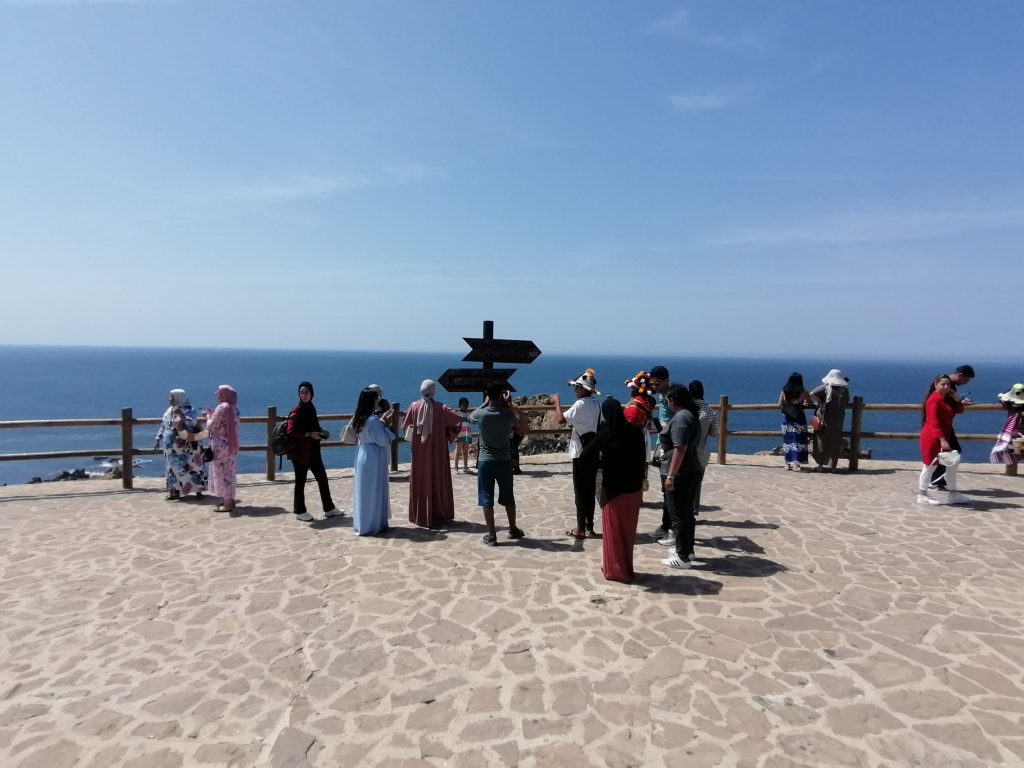
- Tangier was founded by the Phoenicians in the 10th century BC. After them came the Carthaginians, the Greeks, the Romans, the Arabs, the Spanish, Portuguese & British.
- For the Greeks the narrow sea between Tangier & Gibraltar formed the gateway to the mysterious rest of the world. The highest mountains on both sides were the pillars holding up the skies.
Freeport Tangier
From 1923 until 1956 Tangier was an International Zone, governed by five nations: France, Spain, the UK, Italy & Morocco. As a consequence many foreign businessmen & diplomats came over to live in Tangier, but also writers & other artists. Mainly attracted by the bohemian lifestyle that came with the economic & political freedom.
- Many famous writers lived in or visited Tangier at the time, like William Burroughs, Paul Bowles, Jack Kerouac, Truman Capote, Ian Flemming, Hans Christian Andersen, Daniel Defoe, Mark Twain & others.
- As well as some famous rock stars, like Jimi Hendrix & the Rolling Stones. Keith Richards even owned a house in Tangier for many years (until 2008). Mick Jagger still does – nearby at Cape Spartel (see below).
Especially the absence of customs duties & tax regulations made Tangier an escape route for many. A place of decadency, corruption, intrigue, espionage, smuggling & what not. In short, a city without too many rules.
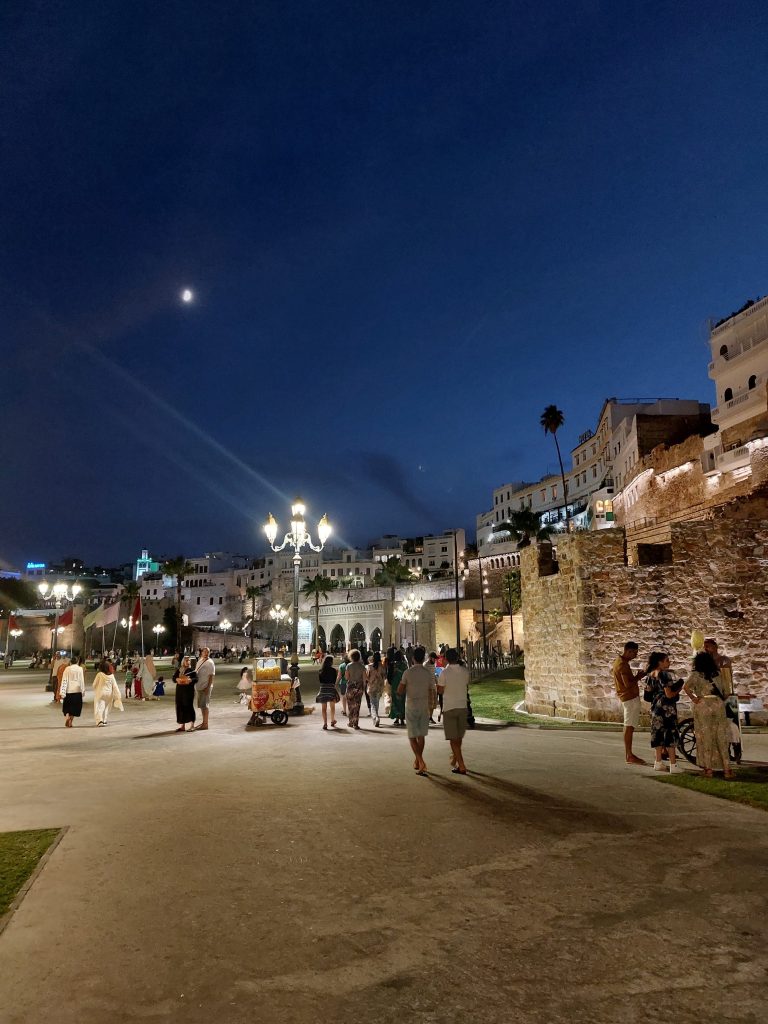
While Tangier converted itself into a party town for the rich & famous, it aroused anger among many locals. People who saw their local culture endangered by eccentric foreigners who – for them – lived a sinful life. A life which completely conflicted with the Islamic religion & its rules.
Many of them considered Tangier “a dissolute, depraved city & a brothel for foreigners”.
*****
- For a longer, yet concise version of the eventful past of the entire country, including the free port of Tangier, go to: History of Morocco
- Besides this short history I’ve prepared another post with general travel tips & ideas for Morocco. Including segments like Getting Around, Personal Safety, Guides & Tours, Weather, Best time to go, Clothing, Shopping, Money. To learn more, go to: Tips & Ideas for your visit to Morocco
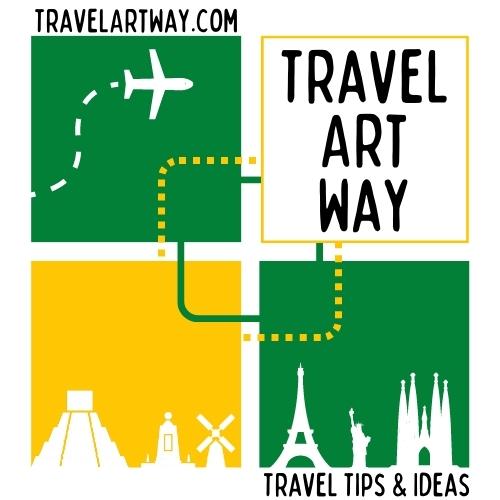
Tangier as a tourist attraction
The central area of Tangier is divided into two parts. The old city or medina & the new city or ville nouvelle are separated by a wide avenue called the Boulevard Pasteur.
As in other Moroccan places, the Medina – a UNESCO World Heritage Site – is a walled city with narrow streets, winding alleyways & bustling markets. One of the – if not THE most – popular tourist attractions in the city.
The Ville nouvelle is the newer part of the city. Home to the government buildings, big businesses, shops & luxury hotels. Noticeably more modern with wide boulevards & European-style architecture. It’s here where you feel the cosmopolitan vibe of Tangier the most.
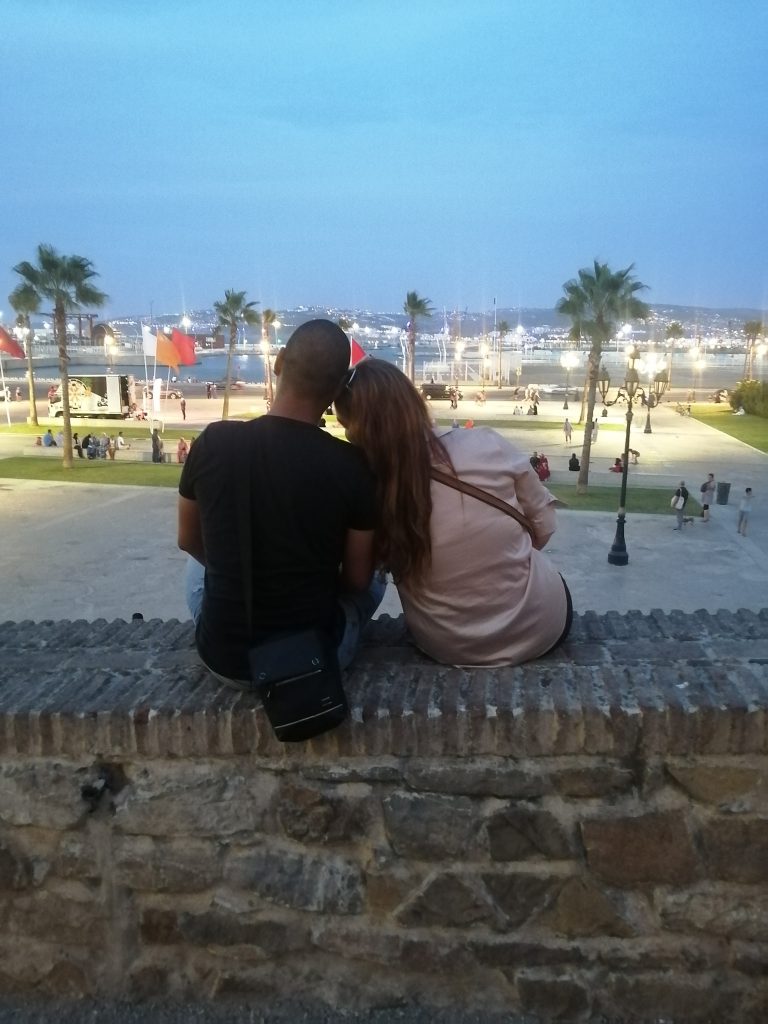
In Tangier you sense a diversity which not only concerns the neighborhoods & buildings you’ll pass, but also the people you meet on the streets. Western style businessmen along Berber mule drivers. Modern style Moroccan girls passing veiled compatriots. Visibly rich families walking past lost vagabonds.
Tangier is home to a number of important historical sites, including the Kasbah, the Grand Mosque, the American Legation & the recently opened Ibn Battuta Museum. Nearby you’ll find relaxing beaches & stunning views of the Mediterranean or Atlantic Ocean, the Street of Gibraltar & the Spanish coast.
In short Tangier stands for: a vibrant culture, an eventful past with a cosmopolitan touch, diversity, historical & architectural highlights, photogenic scenery, relaxing beaches, sightseeing & shopping.

- IMPORTANT: Throughout this post & others I’ll give you TRAVELTips which may help you plan your upcoming visit to Tangier, Morocco. Using links provided by affiliate marketing platforms like TravelPayOuts, GetYourGuide & others.
- If you click on them & buy a ticket for a museum, book a tour or rent a bike a small commission of your purchase will go to me (paid by the provider, without any extra cost to you).
- If you want to learn a little bit more about me, the blog writer, click on: Better call me Art.
Main attractions to visit in Tangier
Visit to the Medina of Tangier
As in Fez & Chefchaouen the old medina is the main attraction to visit in Tangier. To shop & explore, eat & drink, be amazed, surprised, inspired & get lost.
It’s the most lively, mysterious part of every city in Morocco. Although we found the medina of Tangier less imposing than the one in Fez, it’s an absolute MUST VISIT.
- A remarkable difference we noticed between Fez & Tangier is the presence of many antique shops. In the medina, but outside as well. Something which may interest you when visiting Tangier.






That said, again it proved impossible to visit the whole medina of Tangier. A labyrinthine maze of alleyways, ready to eat you up & get lost. Certainly in the Summer Heat of Morocco.
TRAVELTip: As stated in earlier posts, the Moroccan climate in June, July & August is really a factor to take into account. After 7 days of intensive traveling in the interior – Fez, Volubilis, Chefchaouen, Akchour – the tropical heat was taking its toll.
In other words, in Tangier we noticeably lacked the energy to visit all the attractions we had chosen beforehand. This while the Atlantic breezy city of the port city was actually a welcome relief, lowering the temperature considerably in comparison with Morocco’s interior. Still, something to keep in mind.
The Kasbah & Museum
The kasbah or citadel of Tangier borders the sea-port side of the medina. Located at its highest point, it provides a good idea of the inner city & its surroundings. In terms of style, it’s a perfect example of Morrocan architecture, highly influenced by Moorish or Andalusian elements.
Inside its walls you’ll find several important historical sites, like the Kasbah mosque & the Dar el Makhzen, a former palace which nowadays – besides a beautiful inner garden & artisan shops – houses a museum exhibiting all kinds of Moroccan artifacts. In short, a sort of small sized medina within the medina.
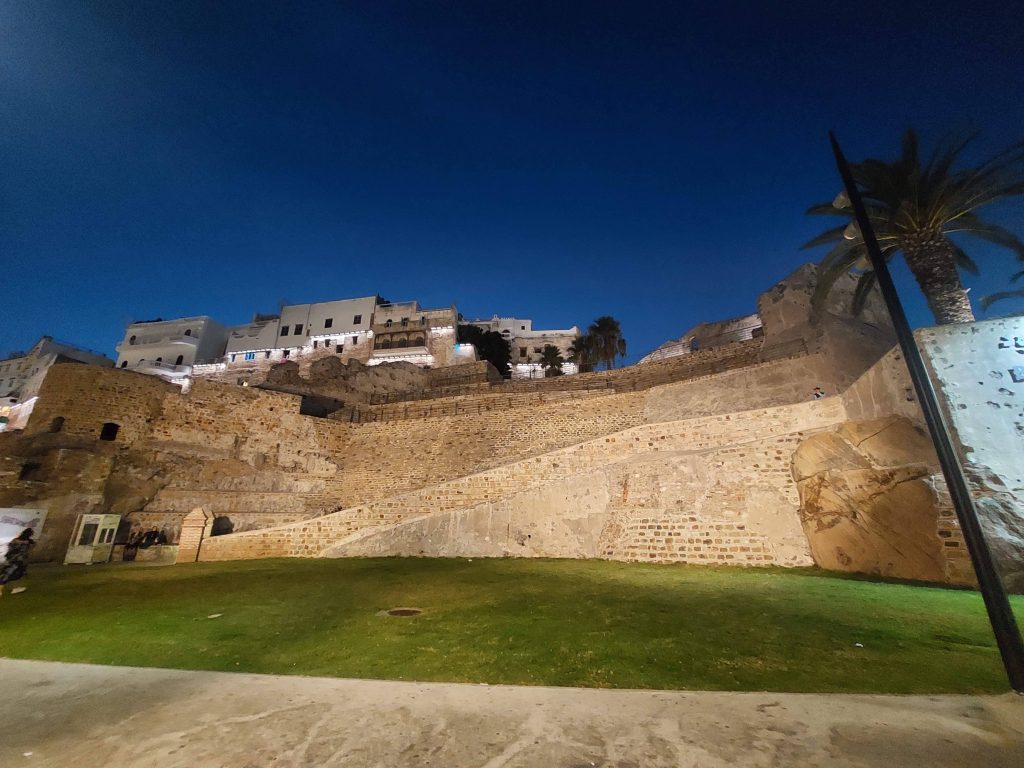
American Legation Museum
A popular museum to visit in Tangier is the American Legation Museum. The museum is located within the medina, in the former home of the American diplomatic mission to Morocco.
- Morocco was one of the first countries in the world to recognise the United States of America after their independence in 1776.
- The American legation opened its doors in Tangier in 1821 and stayed there until Morocco’s independence in 1956 – when the legation moved to the new capital, Rabat.
The museum mainly tells the story of American-Moroccan relations through the years. A relationship which was generally very good. It’s housed in a beautiful Moorish-style building & adjoining garden.
Highlights in the museum – besides the building/garden itself & the beautiful views from the rooftop terrace – are:
- Historical paperwork, like a letter from the First US President George Washington
- A copy of the Treaty of Peace & Friendship between the two countries (1786), the first of its kind with a muslim state.
- The Legation’s flag, featuring the stars & stripes on one side & the Moroccan flag on the other.
- Several Handcrafted gifts, presented to the American government by several Moroccan sultans.
- The Paul Bowles collection (manuscripts, letters, photographs & personal belongings, like his writing desk)
- A unique collection of Moroccan art, besides many pieces of the original furniture.

Visit Tangier: Borj En-Naam Museum
The Borj En-Naam Museum opened its doors just recently (2022) and provides an overview of the Life & Times of one of Tangier’s most distinguished residents: Abu Abdallah Muhammad ibn Battuta (1304-1368).
Ibn Battuta was a muslim scholar who from an early age traveled extensively throughout the Islamic world (14th century).
- Many people call Ibn Battuta “the Marco Polo of the Arab World”. He lived a century after Polo, but travelled over a larger distance than his predecessor. During a period of almost three decades he visited 44 (modern day) countries in Africa, Asia & Europe.
- Ibn Batutta stayed mostly within the bounds of the Islamic World & as an scholar & intellectual mostly met and stayed with men of his own class. The image he describes of the 14th century world though, definitely deserves a place in world’s history.
The museum honoring him is located in the medina, housed in a 17th-century fortress. Highly recommended to spend an hour or two there!
TRAVELTip: The entrance price differs considerably for locals (20DH) & foreigners (50DH). If you don’t like this fact, don’t go,… but you may reconsider knowing the fee supports the maintenance of this beautiful museum.







Booktip
Booktip: As Marco Polo, Ibn Battuta left us his travel stories/diaries. A travelogue (rihla, in Arabic) titled A Masterpiece to Those Who Contemplate the Wonders of Cities and the Marvels of Travelling. Co-written with Ibn Juzayy, a scholar he met in Granada on his journey through Andalusia, Spain.
Alternatively there’s a good biography by Ross E. Dunn (1986), The Adventures of Ibn Battuta – A muslim traveler of the fourteenth century. Although there’s not much specific information on Tangier in this book, it gives you a good idea about the bigger Islamic World of the 14th century.

Tomb of Ibn Battuta
At another location in the medina you’ll find Ibn Battuta’s last resting place. You can visit his tomb, but aren’t allowed to enter the room where his coffin is.
- That said, some people doubt if Ibn Battuta’s remains are really present at this spot. Maybe it’s just another way of preserving his name & fame in Tangier.
- Another good example of remembering this famous “Tangerine” is the Tangier International Airport which carries his name.
The tomb may be a little hard to find, but here’s a link to its location: Tomb of Ibn Battuta
Sidi Hosni Palace
Literally a Hidden Gem within the medina, this former “Sultan’s Palace” was once the residence of one of the wealthiest women in the world. The heiress of the Woolworth Company (Department Stores), Barbara Hutton (1912-1979).
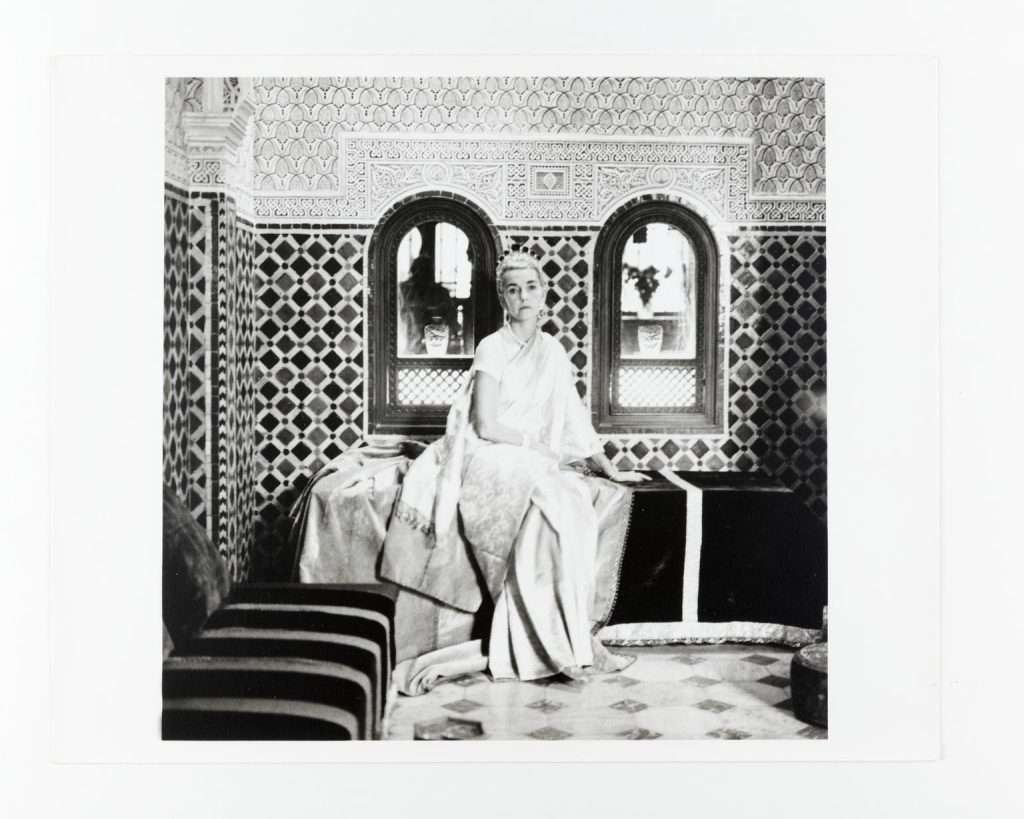
- Many labeled Hutton the “Poor Little Rich Girl“. Although famous for her extravagant lifestyle & house parties, she lived a tormented life and was married no fewer than seven times. Her most famous husband was the American actor Gary Grant.
Nowadays the Palace is private property & only to admire from the outside.
- Very close to the Sidi Hosni Palace, you’ll find another historic place. The Café Baba was the favorite spot for the Rolling Stones every time they exchanged tight-ruled Britain for the free-spirited city of Tangier. Here they could walk around without being recognised too often + drink & smoke “hashies” without getting caught.
- The Stones & other artists regularly came back to Tangier & Café Baba. Keith Richards owned a house in Tangier for years, while Mick Jagger still owns one nearby (see below).
Others attractions to visit in Tangier
Visit Tangier: The Grand Mosque
The largest mosque of Tangier is located on the seaside, near the kasbah. Rather modern in comparison to other mosques in Morocco, it’s another spot to admire the typical Moroccan Islamic architecture. That is, its exterior, as the mosque’s interior is only open to muslims.
- Earlier constructions were found on this particular spot. One of the earliest may even have been a Roman temple, dedicated to the God Hercules. Later on others transformed it into a Church or Mosque, depending on which power was ruling over Tangier.
- The current construction was ordered to be built in 1815 by Sultan Moulay Slimane, member of the still ruling ‘Alawi or Alaouite dynasty.
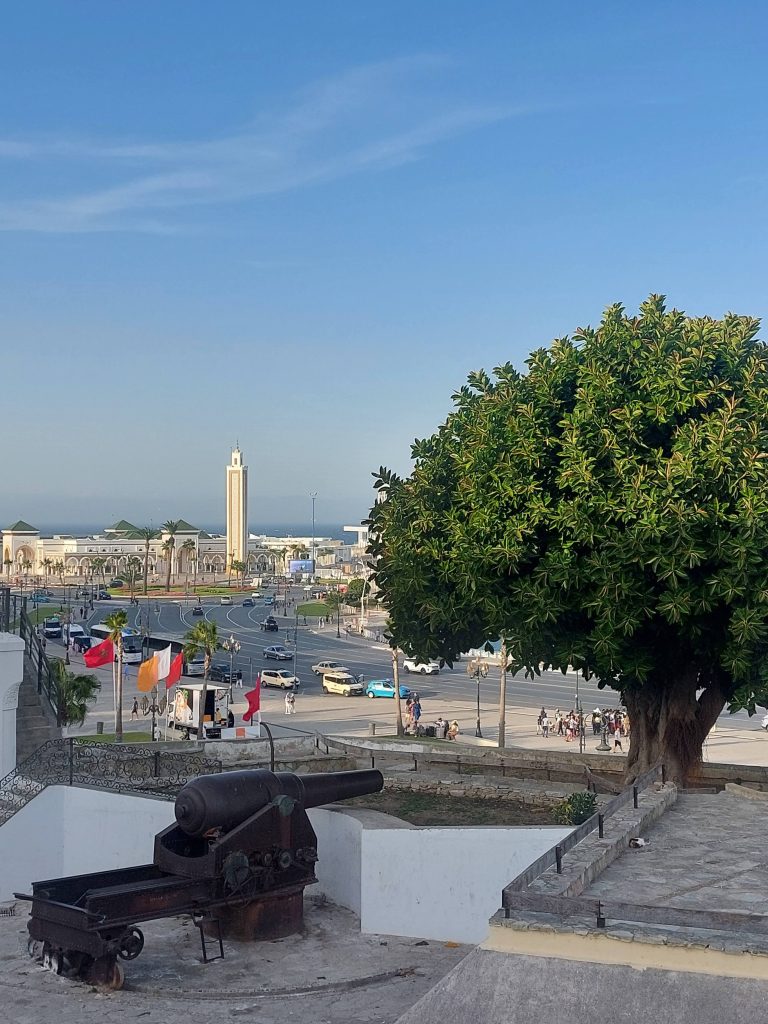
The Grand Socco & Mendoubia Gardens
The Grand Socco nowadays is a pleasant roundabout square – officially named the Place du 9 Avril 1947 – located between the medina & the modern part of town.
Popular because several cafés & restaurants with outdoor seating areas are present on this square. Besides the historical Cinema Rif & the arch that leads to the Mendoubia Gardens.
- Every bigger city is blessed with public gardens like this one. A perfect spot to escape the heat & rest for a while.



Impressions of the Grand Socco, Tangier.
St Andrews Church
St Andrews is a – still functioning – small Anglican church in the central part of Tangier, close to the Grand Socco. A witness to the many British expats who lived in the city & still do.
- Although recognisable at once as a Christian interior, the church has many Moorish, as well as Jewish elements.
Before you enter the church – in principle free, but we were asked for a (small) donation – you’ll pass the adjoining cemetery where several historical residents lay buried.
Inside we were accompanied by a church employee who told us some fascinating stories about the church & past visitors.
- He – amongst other stories – told us about the painter Matisse who lived in the nearby Hotel Villa de France. As well as about the world famous actress Elizabeth Taylor, who visited the church regularly while staying in Tangier.
In conclusion, a short, but surprisingly interesting visit.




Impressions of our visit to the St.Andrews & churchyard.
The Jewish Quarter
Also near the Grand Socco you’ll find the old Jewish Quarter (Mellah) of Tangier.
Although most Jews left Morocco after the Second World War, this historical neighborhood still houses a few synagogues & some Jewish-owned businesses. Besides that, you can visit the Jewish cemetery, which gives you a good idea of the many Jews who once lived in Tangier.
There are organised tours to learn about the Jewish past & present in Tangier.
To learn more, click on: Jewish Heritage Tour Tangier
Visit Tangier: The Marshan
Besides the medina, one of the most beautiful districts of Tangier to visit is the Marshan district.
A photogenic paradise for its mixture of European and Moroccan style mansions & gardens. As well as for its magnificent views of the Strait of Gibraltar & Europe beyond.
Within its boundaries you’ll also find the Royal Palace – occupied by the King & his family when he is in town – the Marshan Gardens, the mythical Café Hafa, the Phoenician Tombs, amongst other Tangier highlights.
- At the western edge of the Marshan District – very near the coastline – you can find the remains of a few dozen Phoenician Tombs. Several valuable artefacts were found in these tombs, but most were Roman. Apparently the Romans emptied the graves & re-used them for their own burials.

Hotel Tip Tangier
We stayed at the Hotel Rembrandt. A somewhat old-fashioned, but good hotel located at the busy Boulevard Pasteur.
- Asking the front desk clerk about the name of our countryman, he told us that the original owner was a big fan of the painter. Enough to honor his name & hang a portrait of Rembrandt van Rijn in the lobby.



Hotel Rembrandt, Tangier.
The biggest advantage of this particular hotel for us was the presence of a big swimming pool, which we used daily.
- Every evening the swimming area was converted into a pool disco. Not really a problem for us, but for some it may be. Although I have to say the music didn’t really reach our rooms.
As a disadvantage I’d like to mention the distance from the hotel to the main attractions, like the medina, kasbah & others. More so, as the hotel is located on a hill. While heading downhill to the city center, the return uphill was somewhat of a battle. Partially because of the summer heat, captured in the busy streets around the hotel.
OK, you could say, not really a problem when there’s the option of taking a taxi. True, and we did, but sometimes it was so busy at the seaside – high season – that it was impossible to get one.
Restaurant Tip Tangier
The best restaurant we visited in Tangier was Kebdani, located in the medina. The night we went it was very busy, but well worth the wait. Run by a local family, it offers good Moroccan dishes & a cozy atmosphere.
That said, I have to say we ate well at all the restaurants we visited in the port city. Also the places to eat near the hotel – along the Tanger Boulevard. Places which, at first sight, weren’t always that inviting to us – less personal, sometimes enormous – but offering many options & good food.
Finally, I’d like to mention the fact that we had the luxury of being located very close to the Café de Paris. A historical place where we enjoyed breakfast twice. A unique café with an European vibe in the middle of Tangier.
- The Café de Paris has a long history. Something you feel right away when you enter. Not only because of its decor, but also because of the fancy, friendly waiters.
- In the past the café was used several times as a location for films like: the Bourne Ultimatum (2007, Matt Damon/Julia Stiles), Inception (2010, Leonardo DiCarpio) & Mission: Impossible – Fallout (2018, Tom Cruise/Rebecca Ferguson).
We loved the place. Highly recommended!

Popular tours in & day-trips from Tangier
Follows a list of the most popular tours in & day-trips around Tangier.
TRAVELTip: If travelling during high season – November to March, but also in July & August – I’d recommend you to book a in advance. First of all to be sure of your participation, and secondly to avoid stress when you least need it.
*Click on the highlighted name (in orange) to learn more about a certain tour or day-trip: That is, a detailed description, duration, price, photos, as well as reviews from earlier participants.
Visit Tangier: Tour of the Medina
Like in other places like Fez, Marrakech or Chefchaouen, the medina is a MUST VISIT when in Tangier. But I highly recommend you to do this the first time with a local guide. Mainly because you surely will get lost when exploring the labyrinthine inner city of Tangier with its many monuments & handicraft shops (souks) on your own.
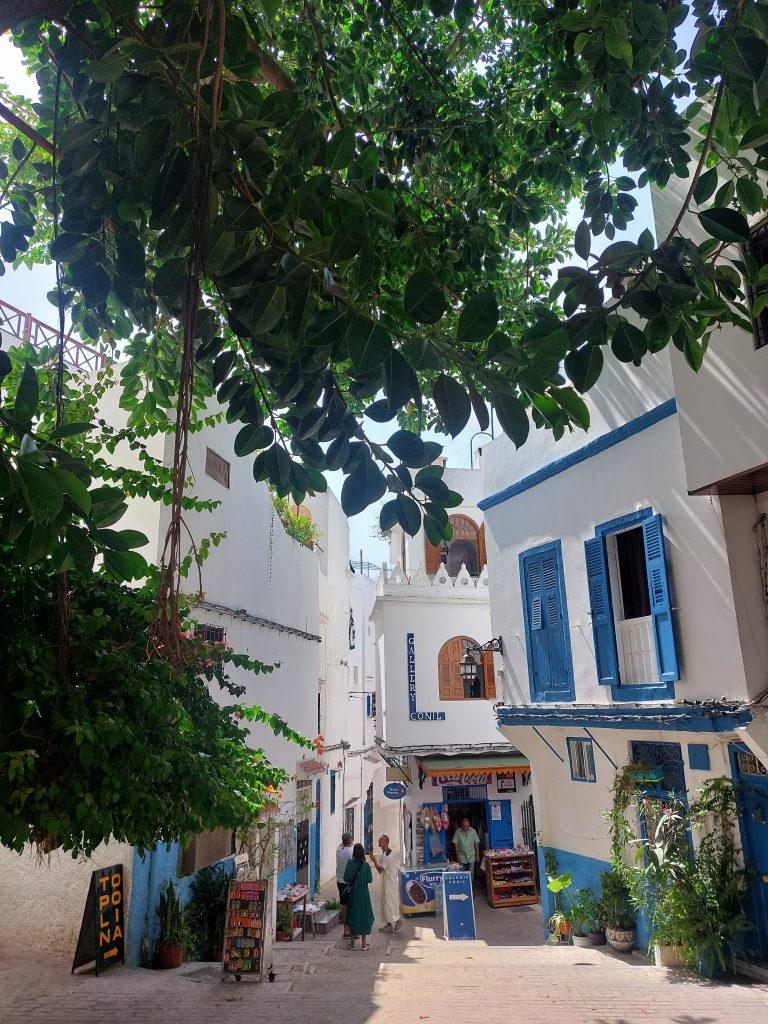
TRAVELTip: There are several tours which cover the medina, but generally in combination with other highlights around. The following tour, for example, also includes a visit to Cape Spartel, near Tangier (see below).
Depending on your wishes you can always incorporate certain attractions you like to visit. Think about the Kasbah Museum, a quick look at the former Palace where Barbara Hutton used to live or the Café Baba – all located within the medina (see above). Just ask your guide before you start the tour.
To learn more, go to: Tour of Tangier
Cape Spartel & the Caves of Hercules
Cape Spartel is the most northern point of Morocco & the nearest to the European continent. Besides the beautiful views over the Street of Gibraltar & Spain, below the cape lay hidden the Caves of Hercules.
Both spots are popular tourist attractions & not far from the city center – only 14km/ 9mi away.
Cape Spartel itself is mainly known for its beautiful historic lighthouse.
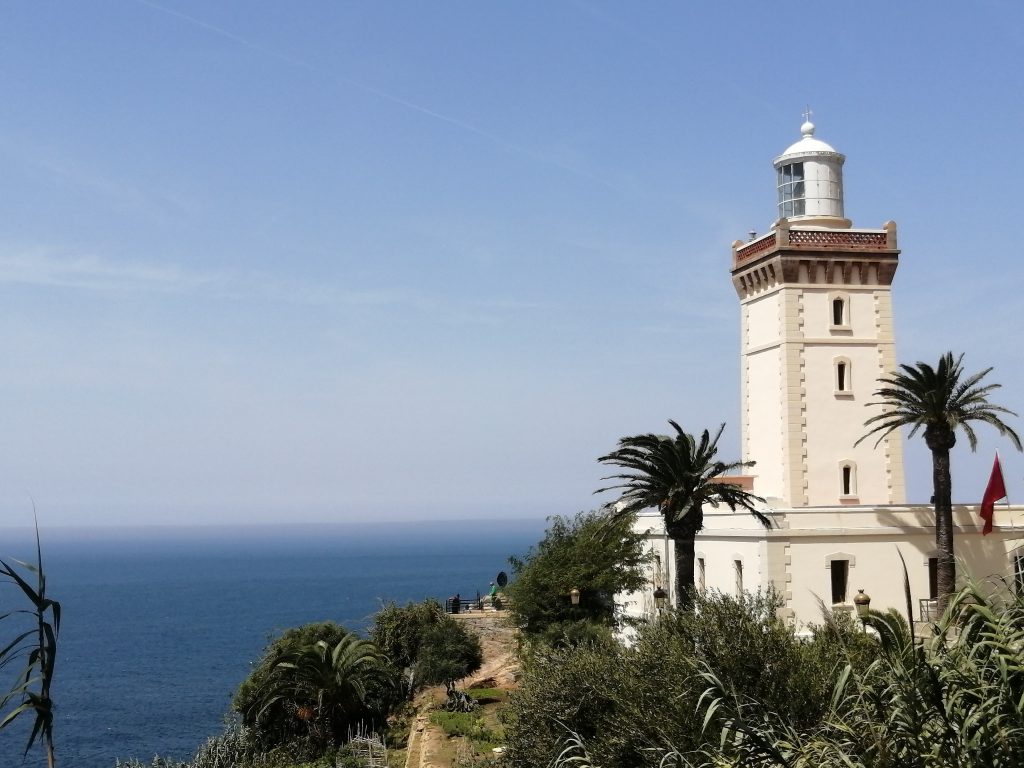
A little to the south – southwest really – of the lighthouse you’ll find the geographical spot where the Mediterranean Sea meets the Atlantic Ocean. It’s marked by a signpost.


Where the Mediterranean meets the Atlantic.
The Caves of Hercules
Further on, you’ll find the mythical Caves of Hercules.
- Evidence has been found, indicating that the caves were inhabited by humans over 6,000 years ago, during the Neolithic period.
- As you may guess, the caves are connected to a legend concerning the Greek god Hercules. The man-god who supposedly visited the caves & created the two pillars marking the far end of the Mediterranean Sea. The Rock of Gibraltar on the Iberian peninsula & Mount Jebel Musa near Tangier.
You can reach the entrance to these caves via the beach below (Robinson Plage or Beach). Or you can (let you) drive down the Route des Grottes d’Hercule.
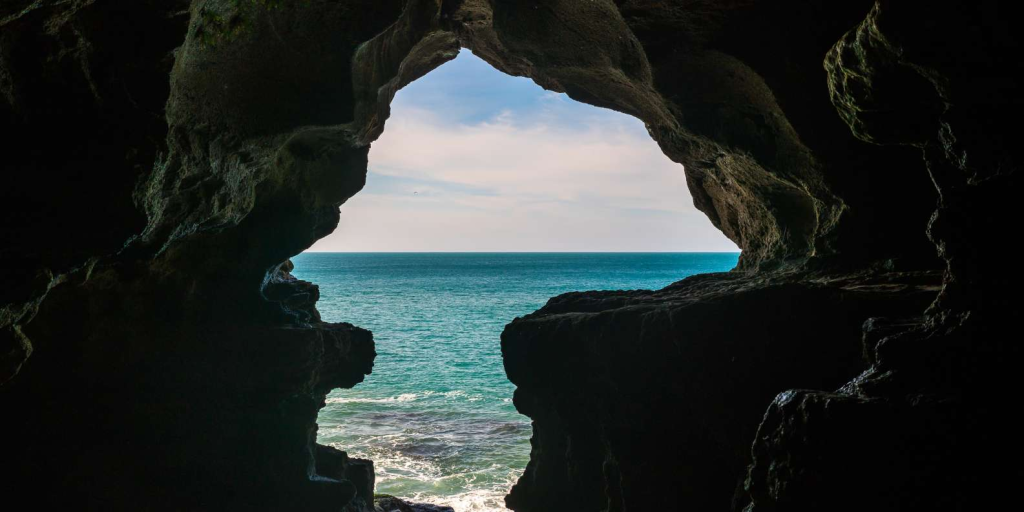
- The opening of the caves to the sea looks similar to the outlines of the African continent. This fact made people in the past believe the sea-fearing Phoenicians were responsible for carving out this entrance.
TRAVELTip: Locals pay 10 Dirham, while foreigners have to pay 60 Dirham. And to be honest, that’s relatively too much money for what you’re going to get. However, when visiting the beautiful Cape Spartel & have time to spare, why not have a quick peek inside.
In conclusion, Cape Spartel is – as we noticed – a popular outing for locals & foreigners alike.
- As well as a preferred spot for the wealthy to build a seaside luxury home. Anew we drove along an enormous palace belonging to the King of Morocco. Located not far from a similar paradise belonging to his colleague of Saudi Arabia. Other famous once-in-a-while residents on the cape are the musicians Mick Jagger & Sting.
How to get to Cape Spartel
You can get to Cape Spartel & Caves of Hercules on your own – hiring a taxi – but both are often included in the organised tours showing you Tangier & around.
To learn more, go to: Tour of Tangier
Besides a sightseeing tour of Tangier itself, a visit to the Cape is generally also included on day-trips to the beaches around Tangier or to beautiful Asilah (see below).
To learn more, go to: Tangier Beach Tour
Day-trip to Asilah
Asilah is a beautiful beachtown near Tangier, located on the Atlantic coast. It’s mainly known for its small, whitewashed medina, the seaside kasbah, its many art galleries & the laid-back atmosphere.
- In the first half of August, Asilah organises it’s yearly Art festival







Asilah, Morocco.
While there, we noticed Asilah is a very popular destination for the Moroccans themselves (many having a holiday home/appartement along the road from Tangier to Asilah).
The best beaches near Asilah are Paradise Beach & Cuevas Beach.
To learn more, click on: Day-trip to Asilah
Chefchaouen Day Trip
If you don’t have a chance to stay a few days in Chefchaouen, I would highly recommend you to go on a day-trip to this beautiful city. The blue pearl of Morocco is located somewhat hidden in the Rif Mountains. A 2.5 hours ride from Tangier.
As the medina of Chefchaouen is small, every tour includes a visit to the kasbah – the local fortress – and the nearby Ras El Maa waterfall.
To learn more about this Blue City in general, go to: My post on Chefchaouen
When you want to know about a tour, click on: Day-trip to Chefchaouen
*****
Alternatively, GetYourGuide offers popular tours to Chefchaouen, including a visit to:
*The Akchour Gorge & Waterfalls (see also My post on Chefchaouen)
*Or else, the nearby City of Tetouan
- Because Tetouan is located midway on the road to Chefchaouen it’s a perfect stop. A welcome break to get an idea of Tetouan’s historical center – medina, kasbah & the old tannery. Another UNESCO World Heritage Site. As Chefchaouen, located in the Rif Mountains.
Our visit to Tangier in a few words
Tangier is a beautiful city to visit. Very different from the other places we visited in Morocco this time – Fez & Chefchaouen. It’s more modern, with a cosmopolitan vibe. Almost European in many ways. People generally were friendly & relaxed.
In comparison with the former destinations, the climate was perfect. The sea breeze, a welcome respite.
Concerning Things to Do in Tangier. There is a lot to do. Certainly when you incorporate visits to the beaches nearby or Cape Spartel – which for me is a MUST VISIT when staying for a few days in Tangier.
Personally I loved the small, but interesting Borj En-Naam Museum decorated around the most famous local of the past, the world traveller Ibn Battuta.
In short, a perfect travel destination.
For more information about our journey through Morocco, click on:
- General tips & ideas for a visit to Morocco
- What to do in Fez & around
- A visit to Chefchaouen, the Blue City
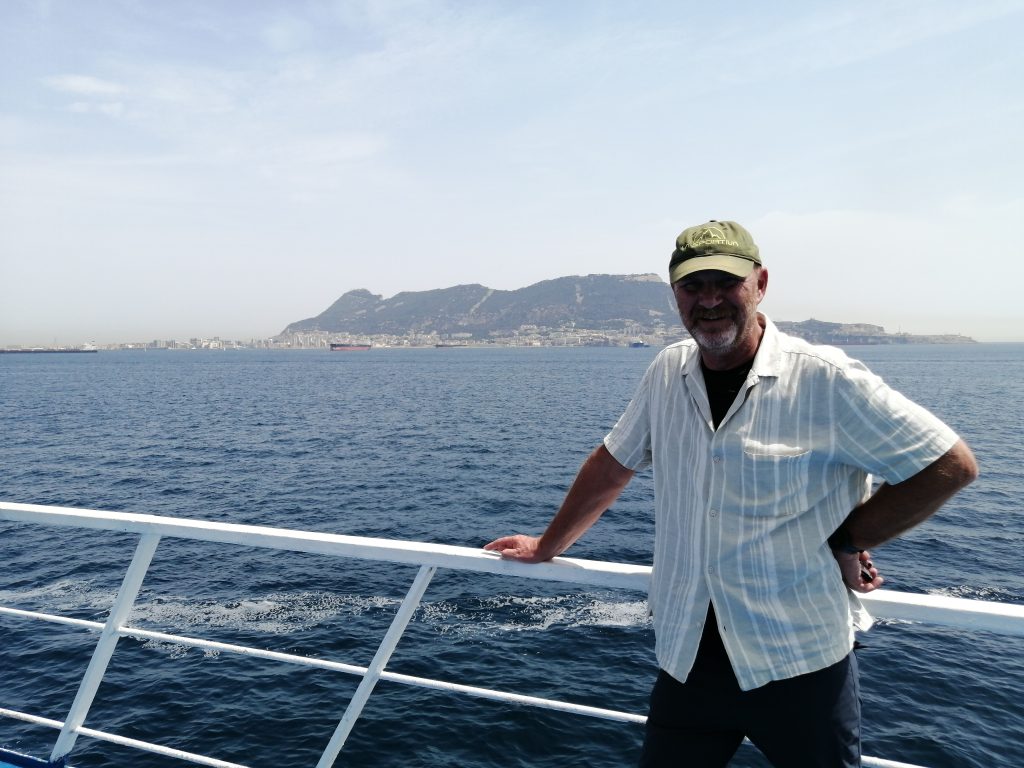

For an overview of all my blog posts, go to: the Home Page.

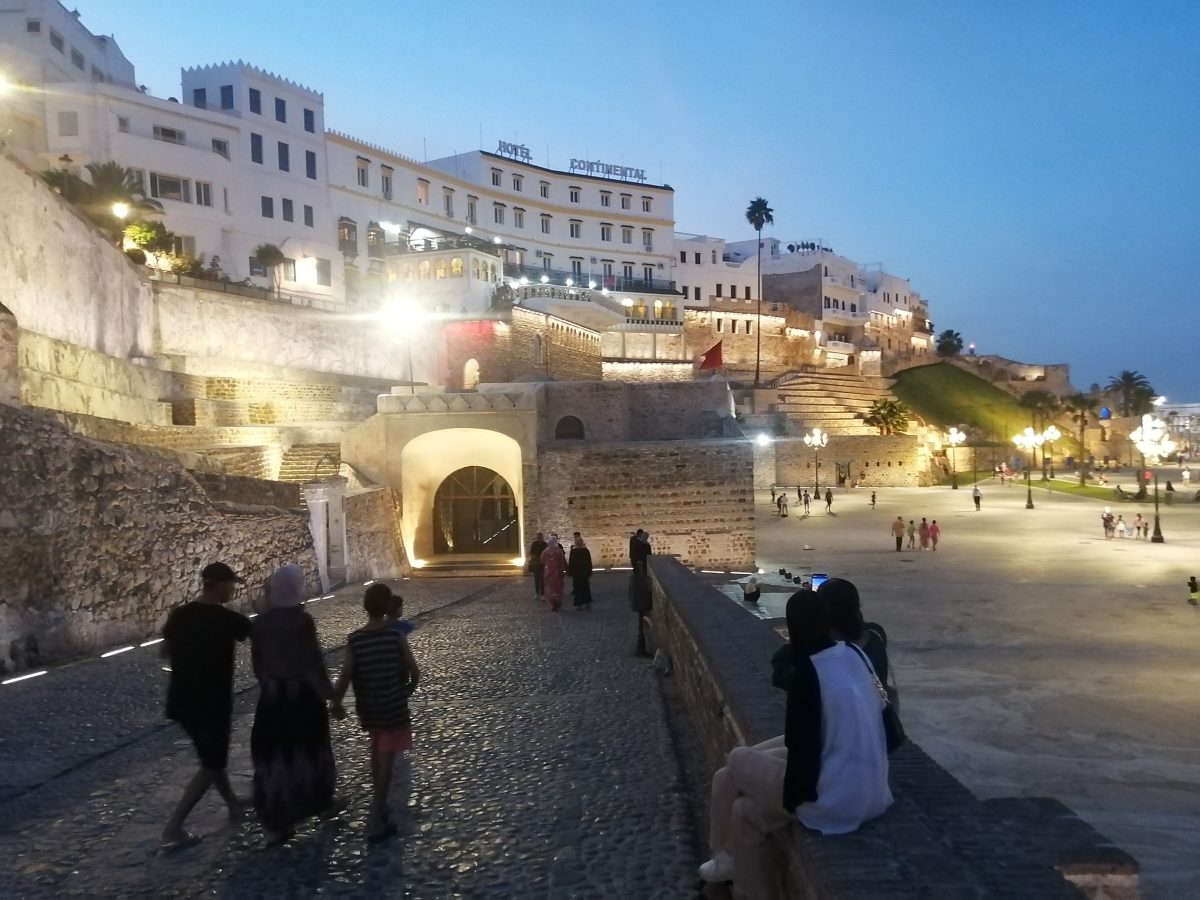
Comments
4 responses to “The Best Tips & Ideas for a perfect visit to Tangier”
[…] The Best Tips & Ideas for a perfect visit to Tangier […]
[…] The Best Tips & Ideas for a perfect visit to Tangier […]
[…] The Best Tips & Ideas for a perfect visit to Tangier […]
[…] The Best Tips & Ideas for a perfect visit to Tangier […]